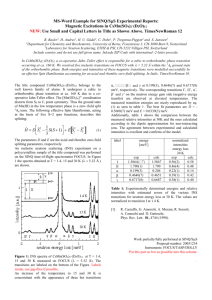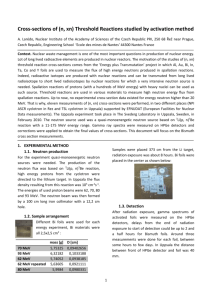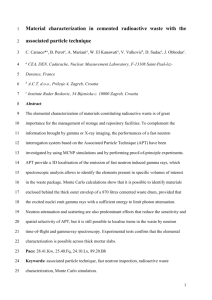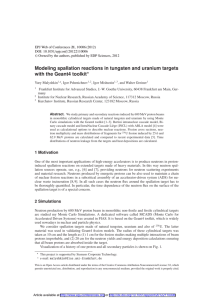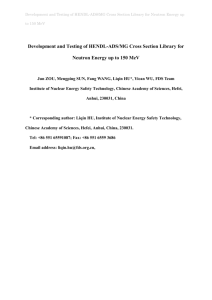Experimental Report Form (Word)
advertisement
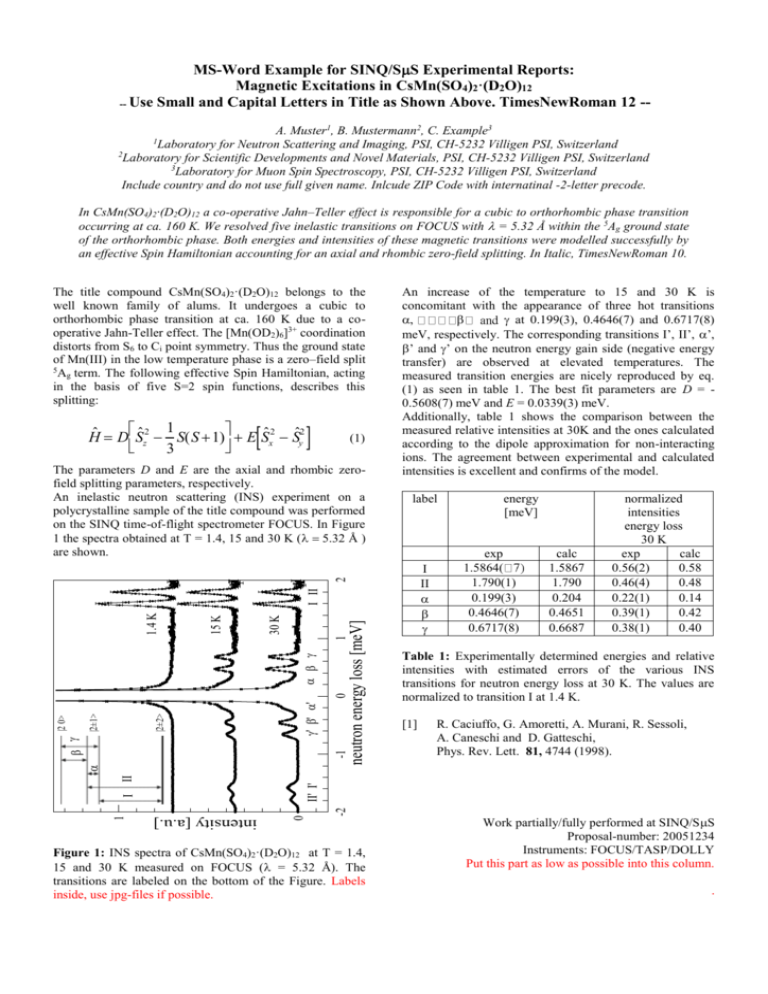
MS-Word Example for SINQ/SS Experimental Reports: Magnetic Excitations in CsMn(SO4)2·(D2O)12 -- Use Small and Capital Letters in Title as Shown Above. TimesNewRoman 12 -A. Muster1, B. Mustermann2, C. Example3 Laboratory for Neutron Scattering and Imaging, PSI, CH-5232 Villigen PSI, Switzerland 2 Laboratory for Scientific Developments and Novel Materials, PSI, CH-5232 Villigen PSI, Switzerland 3 Laboratory for Muon Spin Spectroscopy, PSI, CH-5232 Villigen PSI, Switzerland Include country and do not use full given name. Inlcude ZIP Code with internatinal -2-letter precode. 1 In CsMn(SO4)2·(D2O)12 a co-operative Jahn–Teller effect is responsible for a cubic to orthorhombic phase transition occurring at ca. 160 K. We resolved five inelastic transitions on FOCUS with = 5.32 Å within the 5Ag ground state of the orthorhombic phase. Both energies and intensities of these magnetic transitions were modelled successfully by an effective Spin Hamiltonian accounting for an axial and rhombic zero-field splitting. In Italic, TimesNewRoman 10. The title compound CsMn(SO4)2·(D2O)12 belongs to the well known family of alums. It undergoes a cubic to orthorhombic phase transition at ca. 160 K due to a cooperative Jahn-Teller effect. The [Mn(OD2)6]3+ coordination distorts from S6 to Ci point symmetry. Thus the ground state of Mn(III) in the low temperature phase is a zero–field split 5 Ag term. The following effective Spin Hamiltonian, acting in the basis of five S=2 spin functions, describes this splitting: [ 1 Hˆ = DéSˆz2 - S(S +1)ù + E Sˆx2 - Sˆy2 ë û 3 ] (1) label -1 energy [meV] exp 1.5864( 1.790(1) 0.199(3) 0.4646(7) 0.6717(8) calc 1.5867 1.790 0.204 0.4651 0.6687 normalized intensities energy loss 30 K exp calc 0.56(2) 0.58 0.46(4) 0.48 0.22(1) 0.14 0.39(1) 0.42 0.38(1) 0.40 Table 1: Experimentally determined energies and relative intensities with estimated errors of the various INS transitions for neutron energy loss at 30 K. The values are normalized to transition I at 1.4 K. [1] R. Caciuffo, G. Amoretti, A. Murani, R. Sessoli, A. Caneschi and D. Gatteschi, Phys. Rev. Lett. 81, 4744 (1998). -2 II' I' 0 intensity [a.u.] 1 I II a neutron energy loss [meV] g' b' a' |2±2> b g |2 0> |2±1> 0 a b g 1 30 K 15 K 1.4 K I II 2 The parameters D and E are the axial and rhombic zerofield splitting parameters, respectively. An inelastic neutron scattering (INS) experiment on a polycrystalline sample of the title compound was performed on the SINQ time-of-flight spectrometer FOCUS. In Figure 1 the spectra obtained at T = 1.4, 15 and 30 K ( .32 Å ) are shown. An increase of the temperature to 15 and 30 K is concomitant with the appearance of three hot transitions at 0.199(3), 0.4646(7) and 0.6717(8) meV, respectively. The corresponding transitions I’, II’, ’, ’ and ’ on the neutron energy gain side (negative energy transfer) are observed at elevated temperatures. The measured transition energies are nicely reproduced by eq. (1) as seen in table 1. The best fit parameters are D = 0.5608(7) meV and E = 0.0339(3) meV. Additionally, table 1 shows the comparison between the measured relative intensities at 30K and the ones calculated according to the dipole approximation for non-interacting ions. The agreement between experimental and calculated intensities is excellent and confirms of the model. Figure 1: INS spectra of CsMn(SO4)2·(D2O)12 at T = 1.4, 15 and 30 K measured on FOCUS ( = 5.32 Å). The transitions are labeled on the bottom of the Figure. Labels inside, use jpg-files if possible. Work partially/fully performed at SINQ/SS Proposal-number: 20051234 Instruments: FOCUS/TASP/DOLLY Put this part as low as possible into this column. .
